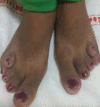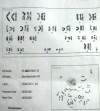Two Distinctively Rare Syndromes in a Case of Primary Amenorrhea: 18p Deletion and Mayer-Rokitansky-Kuster-Hauser Syndromes
- PMID: 32714621
- PMCID: PMC7375842
- DOI: 10.1055/s-0039-1700577
Two Distinctively Rare Syndromes in a Case of Primary Amenorrhea: 18p Deletion and Mayer-Rokitansky-Kuster-Hauser Syndromes
Abstract
Mayer-Rokitansky-Kuster-Hauser (MRKH) syndrome and 18p deletion syndrome, two genetic disorders having distinct genetic etiologies, have an exceedingly rare likelihood of coexistence. Vaginal agenesis or MRKH syndrome, the developmental failure of Mullerian ductal system-derived structures in a genotypic female fetus (46, XX), leads to congenital absence of uterus and vagina in variable degree. The 18p deletion syndrome is a rare chromosomal disorder, characterized by dysmorphic features, stunted growth, and mental retardation, which is caused by deletion of a part or all of the short arm of chromosome 18. A detailed evaluation of primary amenorrhea in a 16-year-old girl yielded both MRKH syndrome and 18p deletion syndrome. Extensive literature search could not identify any reported case bearing this combination of syndromes. This case presentation and review emphasizes on the importance of karyotyping in MRKH patients having atypical features.
Keywords: 18p deletion; MRKH; amenorrhea.
© Thieme Medical Publishers.
Conflict of interest statement
Conflict of Interest None declared.
Figures





References
-
- Petrozza J C. Mayer-Rokitansky-Küster-Hauser syndrome and associated malformations: are they as common as we think? Fertil Steril. 2016;106(05):1047–1048. - PubMed
-
- Baker V L, Schillings W J, McClamrock H J. Philadelphia: Wolters Kluwer Health/Lippincott Williams and Wilkins; 2012. Berek and Novak's Gynecology. 15th ed.
-
- Babovic-Vuksanovic D, Jenkins S C, Ensenauer R, Newman D C, Jalal S M. Subtelomeric deletion of 18p in an adult with paranoid schizophrenia and mental retardation. Am J Med Genet A. 2004;124A(03):318–322. - PubMed
-
- Kumar P, Malhotra N. New Delhi: Jaypee Brothers Medical Publishers (P) Ltd; 2008. Jeffcoate's Principles of Gynaecology. 7th ed.
Publication types
LinkOut - more resources
Full Text Sources

